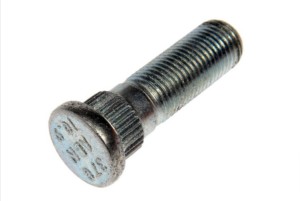Wheel studs are crucial components that ensure your wheels are securely attached to your vehicle. These крепёжные elements can sometimes get damaged, leading to the necessity for replacement. If you’re facing this issue, you might be wondering, “Do all car repair shops do wheel stud replacement?” The short answer is, generally, yes. Wheel stud replacement is a standard service offered by most reputable car repair shops due to its importance for vehicle safety and functionality.
But let’s delve deeper into this topic. While most shops offer this service, understanding the nuances can help you make informed decisions about your car maintenance.
Understanding Wheel Studs and Why They Need Replacement
Wheel studs are the threaded bolts that protrude from the wheel hub. They are designed to secure the wheel to the car using lug nuts. These studs endure significant stress from vehicle weight, driving forces, and frequent tire changes. Over time, or due to specific incidents, wheel studs can become damaged. Common causes for wheel stud damage include:
- Over-Torquing Lug Nuts: Applying excessive force when tightening lug nuts is a primary cause of stud damage. Over-tightening stretches the stud beyond its yield point, weakening it and making it prone to fracture.
- Cross-Threading Lug Nuts: Incorrectly starting lug nuts can damage the threads on both the nut and the stud, requiring replacement of the stud.
- Impact Damage: Accidents or forceful impacts to the wheel area can bend or break wheel studs.
- Corrosion and Wear: Exposure to road salts and moisture can lead to corrosion, weakening the studs over time. Frequent tire rotations and replacements also contribute to wear and tear.
Recognizing the signs of a damaged wheel stud is crucial for timely repair and safety. Key indicators include:
- Difficulty Tightening Lug Nuts: If you notice lug nuts are hard to tighten or don’t feel secure, the studs might be damaged.
- Wheel Wobbling or Vibrations: A damaged stud can cause the wheel to be improperly seated, leading to vibrations while driving.
- Visible Damage: Inspecting the wheel studs might reveal visible cracks, bends, or stripped threads.
- Missing Studs: In extreme cases, a stud might break off completely.
Why Car Repair Shops Offer Wheel Stud Replacement
Wheel stud replacement is not just a convenience service; it’s a safety-critical repair. Car repair shops offer this service because:
- Safety Imperative: Damaged wheel studs compromise wheel security, posing a significant safety risk. A wheel detachment while driving can lead to severe accidents. Repair shops prioritize safety and offer this service to ensure vehicles are roadworthy.
- Common Problem: Wheel stud damage is a relatively common issue due to the stresses they endure. Shops address frequent problems to meet customer needs.
- Part of Wheel and Tire Service: Many shops offer comprehensive wheel and tire services, including tire changes, rotations, and wheel alignments. Wheel stud replacement naturally falls under this umbrella.
- Profitable Service: While safety is paramount, wheel stud replacement is also a standard repair service that generates revenue for auto repair shops.
When to Go to a Repair Shop vs. DIY
While replacing a wheel stud might seem straightforward, it’s a task that requires specific tools and some mechanical knowledge. Here’s a guide to help you decide whether to visit a repair shop or attempt a DIY fix:
Go to a Repair Shop If:
- You lack experience: If you’re not comfortable working on cars or don’t have experience with wheel or brake components, it’s best to leave it to professionals.
- You lack tools: Wheel stud replacement requires specific tools like a torque wrench, jack and jack stands, lug wrench, hammer, punch, and potentially a C-clamp or impact wrench. If you don’t own these, the cost of buying them might outweigh the labor cost at a shop.
- You encounter complications: Sometimes, removing a damaged stud can be difficult, especially if it’s seized or broken. Repair shops have specialized tools and expertise to handle such situations efficiently.
- For Safety and Assurance: For a safety-critical repair like wheel studs, professional service ensures the job is done correctly, with proper torque and inspection, giving you peace of mind.
Consider DIY If:
- You have experience: If you have prior experience with basic car repairs, particularly brake or wheel work, and are comfortable with the process.
- You have the necessary tools: If you already own or can easily access all the required tools.
- You are confident and meticulous: DIY is feasible if you are detail-oriented and can follow instructions carefully.
If you opt for DIY, here are the basic steps involved, similar to the original article’s guide, but remember safety is paramount:
DIY Wheel Stud Replacement: A Step-by-Step Overview
Tools and Materials You’ll Need:
- Vehicle jack and jack stands
- Lug wrench
- Torque wrench
- Replacement wheel stud (ensure it’s the correct type for your vehicle)
- Hammer
- Punch
- Ratchet and socket set
- C-clamp (or wheel spacer and impact wrench as alternative)
- Gloves and safety glasses
Steps:
-
Preparation and Wheel Removal:
- Park on a level surface, engage the parking brake.
- Loosen lug nuts with a lug wrench but don’t remove them completely.
- Jack up the vehicle and secure it with jack stands.
- Remove the wheel.
-
Accessing the Damaged Stud:
- Depending on your car, you might need to remove the brake caliper and rotor to access the wheel hub. Consult your vehicle’s repair manual for specific instructions.
-
Removing the Old Stud:
- Position the punch on the damaged stud from the back of the hub.
- Use a hammer to carefully knock the stud out. There’s usually an opening in the hub assembly for this.
-
Installing the New Stud:
- Align the new stud with the hole in the hub from the rear.
- Use a C-clamp to press the new stud into place. Alternatively, you can use a wheel spacer and lug nut, tightening the lug nut with an impact wrench to draw the stud into the hub. Be careful not to overtighten.
-
Reassembling and Finishing:
- Reinstall the brake rotor and caliper if removed.
- Mount the wheel back on.
- Hand-tighten lug nuts in a star pattern.
- Lower the vehicle.
- Torque lug nuts to the manufacturer’s specified torque using a torque wrench. This is crucial to avoid damage and ensure wheel security.
Safety First:
- Always wear safety glasses and gloves.
- Ensure the vehicle is securely supported on jack stands before working underneath.
- Never overtighten lug nuts or the C-clamp.
- Double-check your work before driving.
Conclusion
So, to answer the initial question: yes, most car repair shops do offer wheel stud replacement. It’s a vital service for vehicle safety. Whether you choose to go to a professional or tackle it yourself depends on your comfort level, experience, and tool availability. If you’re unsure, especially regarding safety-critical components like wheel studs, consulting or hiring a professional car repair shop is always a prudent decision. Remember, maintaining your vehicle’s wheels and крепёжные elements in good condition is paramount for safe driving.
For quality replacement wheel studs and tools, you can explore retailers like AutoZone for parts and expert advice to ensure your repairs are done right.
FAQ
Is it safe to drive with a broken wheel stud?
No, it is extremely unsafe to drive with a broken wheel stud. It significantly increases the risk of wheel detachment, which can lead to accidents and serious injury.
How much does wheel stud replacement cost at a repair shop?
The cost can vary depending on the shop, vehicle type, and the number of studs needing replacement. Generally, expect to pay between $50 to $200 per wheel for professional replacement, including parts and labor.
Can I replace just one wheel stud, or should I replace them in pairs or all of them?
You can replace just the damaged wheel stud. There is no need to replace them in pairs or all unless multiple studs are damaged. However, it’s wise to inspect all studs on the same wheel for signs of wear or damage when replacing one.
How often should wheel studs be replaced?
Wheel studs don’t have a set replacement interval. They should be replaced when they are damaged, show signs of wear, or are compromised due to over-torquing or other factors. Regular visual inspection during tire rotations or brake service can help identify potential issues early.
Will replacing wheel studs affect my wheel alignment?
No, wheel stud replacement does not directly affect wheel alignment. Wheel alignment is related to the suspension and steering geometry, not the wheel studs themselves. However, if you had to remove suspension components to access the wheel hub, it’s always a good idea to have your alignment checked afterward to ensure everything is still within specification.


